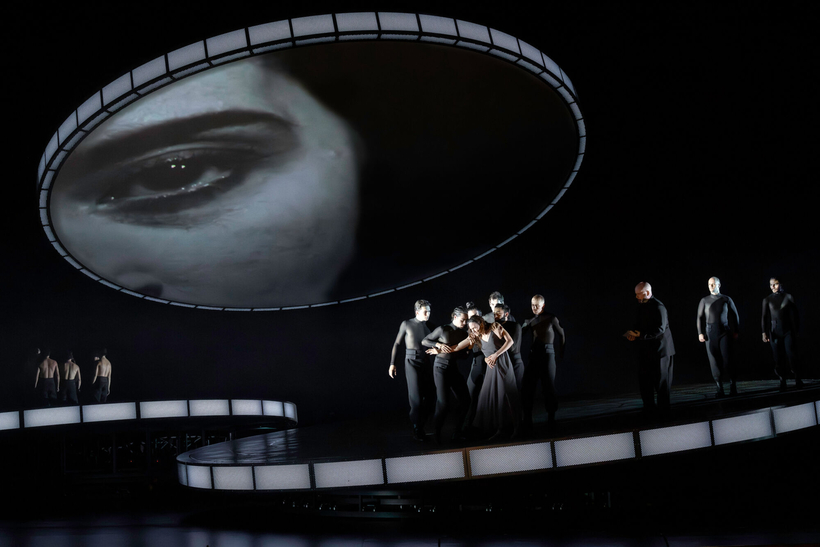It never happened, but what great theater it makes when the Virgin Queen drops in to smack down her captive rival, Mary, Queen of Scots. In Donizetti’s rip-snorting Maria Stuarda (after Schiller), Elizabeth goads Mary, who pays with her life—but not without landing a blow to Elizabeth’s ego from which she will never recover. In a live video from this summer’s Salzburg Festival, Kate Lindsey’s fierce mezzo Elizabeth and Lisette Oropesa’s cornered soprano Mary go at it tooth and nail.
Also, they get plenty of exercise—by my estimate, north of 6,000 steps each. The fitness benefits come courtesy of the director-designer Ulrich Rasche, who keeps both stars onstage a lot more than Donizetti intended. Each occupies her separate tilted turntable, continually trudging at the rate of one robotic step per beat. An all-male movement chorus observes the same discipline, first like toy soldiers, later like writhing souls of the damned. For a few minutes, it’s mesmerizing.

Unknown in America, Rasche is red hot in Europe, and perpetual motion is his middle name. Revolving platforms and tick-tick locomotion—that’s been his shtick in Greek tragedy, German classics, Bach’s St. John Passion, Richard Strauss’s Elektra, and more. His bio name-checks two influences and not one more: the plodding cult choreographer Pina Bausch and the formalist mandarin Robert Wilson. Truth to tell, Maria Stuarda reads as an epigone’s reductio ad absurdum of the Wilson aesthetic, plus a veneer of Bausch.

Be it said that Rasche’s clockwork mechanics are worthy of Patek Philippe. Dig how the queens’ just-so placement on their discs indicates exactly who’s up, strategically speaking, at a given moment, and who’s down. And the uncluttered line of Sara Schwartz’s costumes suits Rasche’s stripped-down aesthetic to a T. That the fabrics transition from opaque to sheer as the queens’ souls are bared is an artful touch.
Too bad that Mary doesn’t get to go out in martyr’s red, the way the real-life Mary did, but then, Rasche’s dress code here is black and white. Mary’s the white queen, Elizabeth’s the black queen, which suggests a chess game—and also a silent movie. What, after all, do the turntables resemble so much as old-time film reels, haunted by avatars of America’s Sweetheart and Norma Desmond?

Oropesa, renowned for highwire bel canto and La Traviata, runs Mary’s slo-mo marathon—the role is endless—with distinction. Her prayer is the score’s most affecting number, and her death amounts to a spiritual victory, telegraphed in this production by a robe like a shower of tiny crystals. But don’t be surprised if it’s the many-faceted Elizabeth who leaves her hooks in you. A singing actress who covers the waterfront from Monteverdi to world premieres, Lindsey delivers total theater. Above and beyond her electric reading of the score, the basilisk stare, square-jawed medallion profile, and calligraphic body language make every moment count, even as Elizabeth’s power slips away. As the Earl of Leicester, whose affections she loses to Mary, the Samarkandian tenor Bekzhod Davronov cuts a romantic figure, has pipes to match, and pours his all into the music. Antonello Manacorda conducts.
Maria Stuarda is available for streaming on medici.tv
Matthew Gurewitsch writes about opera and classical music for AIR MAIL. He lives in Hawaii

